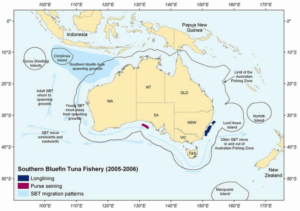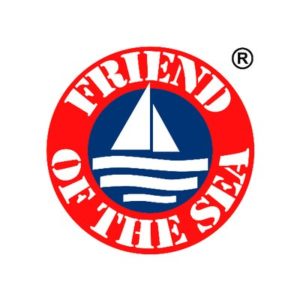The Southern Bluefin Tuna industry has worked tirelessly to recover the population of southern bluefin tuna after years of unregulated fishing. In October 2010 the minister for Environment (SEWPAC) listed the SBT fishery as Conservation Dependent. This title is given to species that have been over-fished but are now being sustainably managed. Early in September 2014, the CCSBT Scientific Committee confirmed that the latest data indicates a strong recovery of the wild population of SBT.
How the industry achieved such a feat was through strict catching limits and industry regulations. There are two managers of the SBT wild fishery in Australia: the Commission for the Conservation of Southern Bluefin Tuna (CCSBT) and the Australian government.

- The CCSBT is an intergovernmental organisation responsible for the management of Southern Bluefin Tuna throughout its distribution. The CCSBT’s objective is to ensure, through appropriate management, the conservation and optimum utilisation of Southern Bluefin Tuna. For more on the roles of CCSBT go to “More information on CCSBT“
- There are multiple agencies in the Australian government that contribute to the management of SBT. These agencies are listed below:
- The Department of Agriculture, Fisheries and Forestry (DAFF): coordinates the Australian approach to the CCSBT
- The Department of Sustainability, Environment, Water, Population and Communities (SEWPAC): administers the Environment Protection and Biodiversity Conservation (EPBC) Act which constantly assess the sustainability of SBT under three seperate parts of the Environment Act
- The Australian Fisheries Management Authority (AFMA): responsible for the efficient management and sustainable use of commonwealth fish resources
SETTING THE QUOTA
Each year the CCSBT Scientific Committee meets and assesses the status of the stock. That committee includes scientists from each Member country and 6 international scientists who make up an independent External Panel. The Scientific Committee annually advises the CCSBT Commission meeting on the stock status and the total allowable catch (TAC) for the SBT fishery. For more information on how the TAC is calculated visit “More information on TACs“.
From 2002 to 2011, the CCSBT conducted extensive work to develop a management procedure (MP) in order to guide the global TAC setting process for SBT. The MP outlines a rebuilding strategy for SBT stock according to the following parameters:
- It is tuned to a 70% probability of rebuilding the stock to 20% of its original spawning stock biomass by 2035
- The minimum TAC change is 100 tonnes
- The maximum TAC change is 3000 tonnes
- The TAC will be set for three-year periods
The TAC for 2014 was 12,449 tonnes, the TAC for 2015 to 2017 was 14,647 tonnes and the TAC for 2018 to 2020 is 17,647 tonnes.
Such increases in quota can be recommended by the Scientific Committee because of the previous large quota cuts in 1988, 2006 and 2009. The large quota cuts gave the species’ spawning mass time to recover to a sustainable level.
The TAC is then allocated out to member countries by the CCSBT. The quota of participating countries in the years 2015 – 2020 is listed below along with their individual TACs:
| Member Countries: | 2015 | 2016-2017 | 2018-2020 |
| Japan | 4,847 | 4,737 | 6,117 |
| Australia | 5,665 | 5,665 | 6,165 |
| Republic of Korea | 1,140 | 1,140 | 1,240.5 |
| Fishing Entity of Taiwan | 1,140 | 1,140 | 1,240.5 |
| New Zealand | 1,000 | 1,000 | 1,088 |
| Indonesia | 750 | 750 | 1,023 |
| South Africa | 40 | 150 | 450 |
| European Union | 10 | 10 | 11 |
 Although the SBT fishery is accredited as sustainable now, the Australian industry is being very cautious about further quota increases, even when scientists recommend the increase.
Although the SBT fishery is accredited as sustainable now, the Australian industry is being very cautious about further quota increases, even when scientists recommend the increase.
Monitoring catch
Operators’ catch against their quota holdings is monitored through logbooks and catch disposal documents and a paper trail of fish receivers. These records are provided to AFMA (Australian Fisheries Management Authority) within legislative time frames to enable AFMA to monitor catch against quota holdings.
The CCSBT has very strict monitoring rules which mean that every individual Southern Bluefin Tuna has its own unique tag and number which allow the fish to be tracked from wild to market. Tracking of individual tuna enables identification of illegal fishing and tightens compliance of CCSBT member countries. Since 1 January 2010, no SBT can be sent for domestic sale, export or accepted for import without the correct accompanying CDS documentation.
For more information on compliance visit: compliance measures.
Increasing Technology
CSIRO has developed a new DNA matching technology called close-kin genetics which enables the SBT spawning stock biomass to be measured differently than current models.
The close-kin data appear to substantially reduce the uncertainty around the trend of spawning biomass over the most recent decade. The data gives a somewhat more positive view of the SBT stock status. The result shows the spawning stock to be at least three times the level calculated by previously used models (calculated at 6 – 11%). These results are powerful, and clearly demonstrate the potential of using close-kin for ongoing monitoring of the SBT spawning stock. CCSBT has agreed that in the longer term, 2018 and beyond, the preferred method to estimate recruitment to the SBT stock will be gene-tagging.
“CCSBT has agreed that there is a need to ensure that there remains a robust science-based MP in place to guide TAC setting. To ensure the current MP is able to adjust to changes in recruitment monitoring processes and work being undertaken in relation to unaccounted mortality on a new MP will be developed by 2019. See AFMA Submission – EPBC Act Reassessment Southern Bluefin Tuna Fishery April 2016
FISHING METHODS
 The vast majority of Australia’s catch is caught using purse seine nets (greater than 90%), which targets surface schools of SBT. All of ASBTIA’s member companies use this method to catch their quota of tuna. In purse seining a boat releases the net and encircles the school of fish, until it recovers the first end of the net. The bottom of the net is held down by weights and the top of the net is made buoyant through the use of buoys. The bottom of the net is then enclosed, capturing the fish within the net.
The vast majority of Australia’s catch is caught using purse seine nets (greater than 90%), which targets surface schools of SBT. All of ASBTIA’s member companies use this method to catch their quota of tuna. In purse seining a boat releases the net and encircles the school of fish, until it recovers the first end of the net. The bottom of the net is held down by weights and the top of the net is made buoyant through the use of buoys. The bottom of the net is then enclosed, capturing the fish within the net.
Because specific schools of fish are targeted, the purse seine method is generally size and species specific, resulting in minimal by-catch. Minimal habitat impacts occur during purse seine operations, as contact with habitat rarely occurs. Based on current information, the level of marine mammal interaction with Australian tuna purse seine operations is considered low.
The remainder of the catch is either targeted or taken incidentally by pelagic longline vessels operating in the Eastern Tuna and Billfish Fishery and to a lesser extent, the Western Tuna and Billfish Fishery.

INTERNATIONAL AND INDEPENDENT SUSTAINABILITY ASSESSMENT
In 2013, the CCSBT commissioned an independent quality assurance consultant, SAI Global, to assess the SBT management system of each CCSBT member country. See the SAI Report on Australia – www.ccsbt.org CCSBT-CC/1410/10, August 2014. The main SAI conclusion is: “Australia’s SBT management systems have been shown to be effective in terms of CCSBTs minimum performance requirements, with well-established fisheries legislation, a strong fisheries management regulatory system, and established fisheries reporting sanctions.” The SAI report or Australia was accepted by the CCSBT in October 2014 (see www.ccsbt.org ‘Report of Compliance Committee’).
The SBT Fishery was originally declared an approved Wildlife Trade Operation under the Environment Protection and Biodiversity Conservation (EPBC) Act 1999 on November 2004. Since then the SBT Fishery has been re-approved under the EPBC Act three times with the current WTO accreditation valid until 2016. To gain this approval, SBT has to be sustainably managed in Australia under the stringent sustainability provisions in Section 303FR of the Act. The accreditation reiterated that fishing techniques and catching of SBT for ranching has no ecosystem impact.
 In 2015 the industry was awarded the internationally recognised Friend of the Sea sustainability certificate. The certification uniquely encompasses both catching of SBT from the wild and aquaculture of the fish in pens near Port Lincoln. Bluefin and its origins are audited against the Friend of the Sea sustainable fishery criteria. This includes non-exploitation of target stock, no impact on critical habitats, no by-caught endangered species, compliance with legal requirements, energy efficiency and waste management.
In 2015 the industry was awarded the internationally recognised Friend of the Sea sustainability certificate. The certification uniquely encompasses both catching of SBT from the wild and aquaculture of the fish in pens near Port Lincoln. Bluefin and its origins are audited against the Friend of the Sea sustainable fishery criteria. This includes non-exploitation of target stock, no impact on critical habitats, no by-caught endangered species, compliance with legal requirements, energy efficiency and waste management.
SUSTAINABILITY OF FEED SUPPLIES
The SA sardine fishery remains the major feed source for SBT ranching. The SA sardine fishery is managed in a precautionary way, based on decision rules linked to egg surveys and sardine fish size (length) in the catch. See PIRSA for the history and management of the sardine fishery.
The 2015 sardine quota has been fixed on 14/10/14 at 38,000 tonnes, compared with 34,000 tonnes in 2014. This is near historical highs – reflecting the very high 2014 egg survey. The fishery is managed by ITQ’s with a maximum 14 licences.
Over 96% of the SA quota is used for SBT ranching feed. Of this, about 80% is fed fresh direct into the pontoons after catching and the balance is fed frozen.
Imported feed is around 15,000 tonnes, largely from California (www.abs.gov.au) The California (West Coast stock) is also managed in a precautionary way (see www.swfsc.noaa.gov)
MORE INFORMATION
For more information on the sustainability of tuna ranching visit “Ranching sustainably under the SA Aquaculture Act“.
Management of SBT in Australia